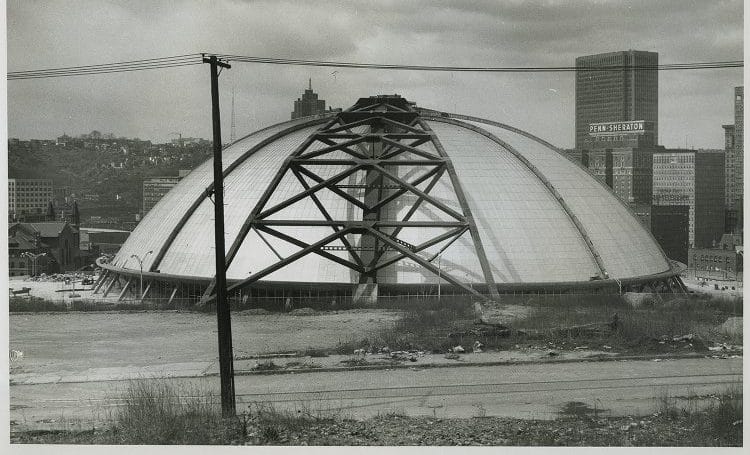
Civic Arena site prior to construction – Senator John Heinz History Center – Historic Pittsburgh Image Collection
BikePGH honors Black History Month
Race, Public Space, and Public Safety
“Traffic Safety” is not a colorblind term. As we advocate for streets and communities that are safe and accessible for everyone to bike and walk, we must address the barriers that disproportionately affect communities of color in public spaces. The barriers rise from a web of factors that all suffer from histories of institutionalized racism – racial profiling in public spaces; the ways development has shaped and reshaped our neighborhoods; and the policies that dictate how and who moves through them. These all create a more dangerous reality for black people and people of color.
Racial Profiling In Public Spaces
When we look back through urban histories we see how race has influenced individual understandings of what public space is, who it is intended for and what the expectations of “public safety” are in these spaces. Surely one of the first things that comes to mind when discussing “public safety” or “traffic safety” is the police. Though unfortunately when we look at how many policing strategies – such as “broken-windows”, “zero tolerance” or “quality of life” policing– have been implemented, we see that they do not work as intended. We also see that they disproportionately victimize people of color. In 2012, racial minorities accounted for 92% of all stop-and-frisk incidents by NYPD. Furthermore, studies show that unarmed black Americans were five times as likely as unarmed white Americans to be shot and killed by a police officer. Trending hashtags #drivingwhileblack, #walkingwhileblack, #blackinpublic share real lived experiences that further reveal the inherent threat black and brown people are presented while moving through public space on a daily basis (see Ricky Williams, Bruce Kelly Jr., Jacqueline Craig, Trayvon Martin, Philando Castile, Sandra Bland, and countless more).
Development and Policy Shape Our Neighborhoods and Our Mobility

Civic Arena Facing East – Senator John Heinz History Center – Historic Pittsburgh Image Collection
BikePGH recently published a detailed Report on Pedestrian and Bicycling Safety in Pittsburgh which finds that pedestrians and bicyclists are killed at a higher rate than auto drivers, and account for a large share of all fatal crashes in Pittsburgh. While only 6% of all traffic crashes involved pedestrians, they accounted for a stunning 26% of Pittsburgh’s traffic fatalities from 2011-2015. Though we do not yet have the local data, nationally these staggering numbers are magnified even further when you consider the economic policies have shut people of color out of home ownership and car ownership.
Through these policies, POC are forced to rely on walking, biking and public transit for transportation, which disproportionally exposes them to the risk of traffic violence.
Add to that the fact that these same policies and others have slated many marginalized neighborhoods for demolition to make way for highways and other large-scale projects, where fast moving traffic and dangerous driving put these communities further at risk. A recent NPR interview with public health researcher Courtney Coughenour even explained that drivers were less likely to yield to the African-American pedestrian when they were in the roadway compared to the white pedestrian. From public policy to individual action, the ways that America’s institutionalized racism works to endanger the lives of people of color are incredibly complex and painfully deep.
What Works? What Doesn’t?
It is crucial that our work put power back in the hands of the people. We can do this through community organizing, elevating and engaging diverse leaders, collecting data, recommending anti-racist policies, and listening to people in communities affected by new development or policy. By centering the voices and histories of the most marginalized people in our communities, we can meaningfully build and prioritize development that is inclusive, reduces harm for all people, and works to catalyze safer streets and communities.
4 Comments
[…] Part 3: Race, Public Space, And Public Safety […]
[…] Part 3: Race, Public Space, And Public Safety […]
[…] Part 3: Race, Public Space, And Public Safety […]
[…] Part 3: Race, Public Space, And Public Safety […]